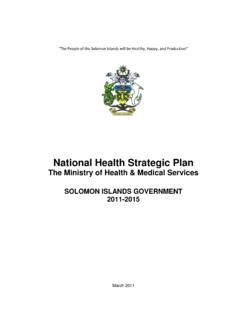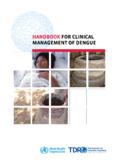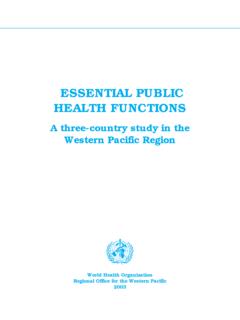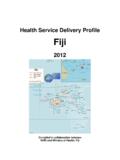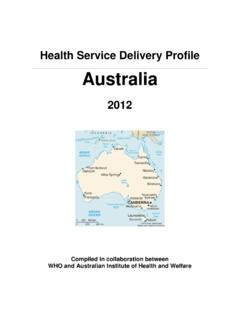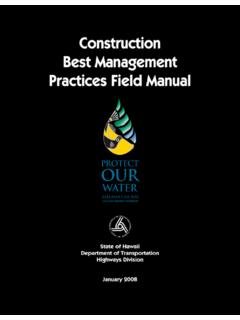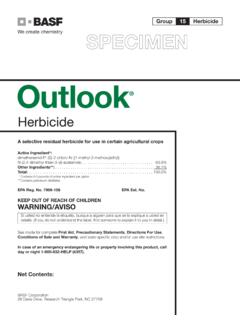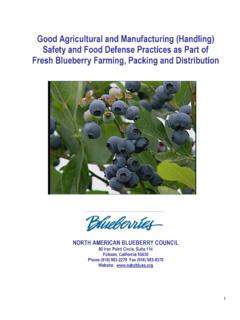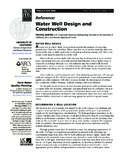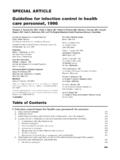Transcription of Breastfeeding TSEK* Tama, Sapat, Esklusibo - WPRO
1 PROTECT INFANT HEALTH. SAVE LIVES. Breastfeeding TSEK tama , Sapat, Esklusibo Contents of Infants and Children Evidence for Breastfeeding & Health Policies Programs & Strategies TSEK: Protecting Community Infants & Young Children The Situation of Infants and Children 1 4 The State shall protect and promote the right to health of the people and shall instill health consciousness among them. Philippine Constitution, Art 2, Section 15 The State protects a Child s right to Life and Good Health 5 Our National Commitment The Philippines is committed to achieve the Millennium Development Goals (MGD) by 2015. One of 4 children, under 5 years, is malnourished NUTRITIONAL STATUS PREVALENCE ESTIMATED NUMBER (IN MILLION)* Underweight Underheight Thinness Overweight Source: 7th National Nutrition Survey, 2008 The continued high rates of moderate and severe stunting (30%) and low birthweight (20%) highlight the need for greater attention to improving maternal nutrition and complementary feeding.
2 The State of the World s Children 2009 8 Poor Nutritional Status Predisposes to: increased severity and duration of diarrhea attacks Increased risk of dying from diarrhea Ashworth and Feachem. Interventions for the control of diarrhoeal diseases among young children: weaning education. Bulletin of the World Health Organization, 63 (6): 1115-1127 (1985) 9 Mortality Impact of Underweight 5% reduction in low weight for age by 2005 30% reduction in child mortality 10 Source: Pelletier and Frongillo. 2003. Pooled analysis of data from 59 countries from 1966 to 1996. Breastfeeding evens the playing field Breastfeeding is a natural "safety net" against the worst effects of is almost as if Breastfeeding takes the infant out of poverty for those first few months in order to give the child a fairer start in life and compensate for the injustice of the world into which it was born. James P.
3 Grant Former Executive Director UNICEF 3 4 Reduce by two thirds the under-five mortality rate between 1990 and 2015 Key Facts million children under the age of five die every year (2010 figures). More than half of these early child deaths are due to conditions that could be prevented or treated with access to simple, affordable interventions. Leading causes of death in under-five children are pneumonia, preterm birth complications, diarrhoea, birth asphyxia and malaria. About one third of all child deaths are linked to malnutrition. 13 Source: WHO. Global Health Observatory ( ) CAUSES OF UNDER FIVE DEATHS, 2010 1 of 4 Philippine children under five years of age are at risk of infection & death Source: WHO. Global Health Observatory ( ) Our newborns are at risk of dying in the first 2 days of life Strategies appropriate home care and timely treatment of complications for newborns integrated management of childhood illness for all children under five years old expanded program on immunization infant and young child feeding 16 Exclusive Breastfeeding Rates by Region Why breast milk?
4 Breast milk Artificial Milk Protein Correct amount Easy to digest Partly corrected Fat Enough essential fatty acids, lipase to digest No lipase Water Enough May need extra Anti-Infective Properties Present Immunizes & Protects ABSENT Adapted from: Breastfeeding counselling: A training course. Geneva, World Health Organization, 1993 (WHO/ ). 19 If a new vaccine became available that could prevent one million or more child deaths a year, and that was moreover cheap, safe, administered orally, and required no cold chain, it would become an immediate public health imperative. Breastfeeding can do all this and more. - 1994 Evidence presented in the Series on Child Survival 2003 , Series on Neonatal Survival 2005 , and the Series on Maternal and Child Undernutrition 2008 , clearly pointed out the importance of exclusive Breastfeeding for the first six months of life which could save more lives than any other intervention studied while enhancing nutritional status 20 The Clinical Evidence on Exclusive Breastfeeding at Birth to 6 months 2 Effect of Breastfeeding 22 For the vast majority of infants and young children throughout the world, Breastfeeding saves lives prevents morbidity promotes optimal physical and cognitive development reduces the risk of some chronic diseases Evidence of the benefits of Breastfeeding for mothers is growing as well Leon-Cava et al.
5 Quantifying the Benefits of Breastfeeding : A Summary of the Evidence. Washington, : PAHO 2002 Infant Morbidity and Mortality The greatest and most obvious benefits of Breastfeeding are for the immediate health and survival of the infant 23 Infant Morbidity and Mortality Rates of diarrhea, respiratory tract infections, otitis media, and other infections, as well as deaths due to these diseases, are all lower in breastfed than in non-breastfed infants Exclusively breastfed infants have at least 2 times fewer illness episodes than infants fed breast-milk substitutes. 24 Source: Jones et al., 2003,; Chandra, 1979; Feachem, 1984; and Victora, 1987. Protection Against Infection 25 INFECTIONS % REDUCTION Acute otitis media (exclusive BF 3-6 mos.) 50% Recurrent otitis media (exclusive BF >6 mos.) 77% Upper respiratory tract infection (exclusive BF >6 mos.) 64% Lower respiratory tract infection (exclusive BF >6 mos.) 77% Gastroenteritis 64% Source: American Academy of Pediatrics Policy Statement: Breastfeeding and the Use of Human Milk, originally published online February 27, 2012 Neonatal Conditions INFECTIONS % REDUCTION Necrotizing enterocolitis 77% RSV bronchiolitis (exclusive BF >4 mos.)
6 74% Sudden Infant Death Syndrome (SIDS) (any > 1 month) 36% Source: American Academy of Pediatrics Policy Statement: Breastfeeding and the Use of Human Milk, originally published online February 27, 2012 Percentage of infants 2-7 months of age reported as experiencing ear infections, by feeding category in the preceding month in the Adapted from: Scariati PD, Grummer-Strawn LM, Fein SB. A longitudinal analysis of infant morbidity and the extent of Breastfeeding in the United states . Pediatrics, 1997, 99(6). Risk of diarrhea by feeding method for infants aged 0-2 months, Philippines Adapted from: Popkin BM, Adair L, Akin JS, Black R, et al. Breastfeeding and diarrheal morbidity. Pediatrics, 1990, 86(6): 874-882. Type of Feeding Hospitalized low birth weight infants who were fed with formula milk had 4 times the incidence of serious illness compared to those infants who were breastfed. 29 Randomized Controlled Trial of Low Birth Weight Hospitalized Neonates comparing type of feeding vs.
7 Percentage with serious illness There is a 2-4 fold increase in neonatal mortality rate (NMR) in not receiving colostrum. There is a 5-13% decrease in NMR with exclusive Breastfeeding Babies who were not breastfed in the first 6 months of their lives are 25 times more likely to die than those who experienced exclusive Breastfeeding from the time they were born. Infant Mortality Source: Jones et al., 2003,; Chandra, 1979; Feachem, 1984; and Victora, 1987. The timing of initiation of Breastfeeding is important as there is a higher risk of death among infants with longer delay in the initiation of Breastfeeding . Early Breastfeeding initiation Mullany LC, et al. JNutr, 2008; 138(3):599-603. Delaying Initiation of Breastfeeding increases risk of infection-related death Nepal 2008 N = 22,838 breastfed babies Relative risks of death from diarrhoeal disease by age and Breastfeeding category in Latin America Adapted from: Betran AP, de Onis M, Lauer JA, Villar J.
8 Ecological study of effect of breast feeding on infant mortality in Latin America. BMJ, 2001, 323: 1-5. Relative risks of death from acute respiratory infections by age and Breastfeeding category in Latin America Adapted from: Betran AP, de Onis M, Lauer JA, Villar J. Ecological study of effect of breast feeding on infant mortality in Latin America. BMJ, 2001, 323: 1-5. Protection Against Allergy 36 ILLNESS % REDUCTION Atopic dermatitis (negative family history) (exclusive BF > 3 mos.) 27% Atopic dermatitis (positive family history) (exclusive BF > 3 mos.) 42% Asthma (atopic family history) (exclusive BF > 3 mos.) 40% Asthma (no atopic family history) (exclusive BF > 3 mos.) 26% Source: American Academy of Pediatrics Policy Statement: Breastfeeding and the Use of Human Milk, originally published online February 27, 2012 Protection Against Diseases 37 DISEASE % REDUCTION Type I diabetes (exclusive BF > 3 mos.) 30% Type 2 diabetes (any) 40% Leukemia (ALL) (exclusive BF > 6 mos.)
9 20% Leukemia (AML) (exclusive BF > 6 mos.) 15% Obesity (any) 24% Source: American Academy of Pediatrics Policy Statement: Breastfeeding and the Use of Human Milk, originally published online February 27, 2012 Breastfeeding decreases the prevalence of obesity in childhood at age five and six years, Germany Adapted from: von Kries R, Koletzko B, Sauerwald T et al. Breast feeding and obesity: cross sectional study. BMJ, 1999, 319:147-150. Breastfeeding increases intelligence Child Development Breastfeeding was associated with significantly higher scores for cognitive development than was formula feeding Premature infants derive more benefits from breast milk than do full-term infants The benefits of Breastfeeding increased with duration Anderson et al. Breast-feeding and cognitive development: a meta-analysis. Am J Clin Nutr 1999;70:525 35 40 Child Development Largest randomized trial ever conducted in the area of human lactation (17,046 infants) strongly suggest that with prolonged and exclusive Breastfeeding : Improvement in cognitive development as measured by IQ (verbal IQ, performance IQ, full-scale IQ) Teachers academic ratings at age years were significantly higher for both reading and writing Kramer et al.
10 Breastfeeding and Child Cognitive Development :New Evidence From a Large Randomized Trial. Arch Gen Psychiatry. 2008;65(5):578-584 41 Duration of Breastfeeding associated with higher IQ scores in young adults, Denmark Adapted from: Mortensen EL, Michaelsen KF, Sanders SA, Reinisch JM. The association between duration of Breastfeeding and adult intelligence. JAMA, 2002, 287: 2365-2371. 43 Benefits of Breastfeeding for the mother Short-term Benefits Decreased post-partum blood loss Rapid involution of the uterus Decrease in post-partum depression Increased child spacing due to lactation amenorrhea 44 Source: American Academy of Pediatrics Policy Statement: Breastfeeding and the Use of Human Milk, originally published online February 27, 2012 Long-term Benefits Reduced risk of chronic diseases: Type 2 diabetes mellitus (no history of gestational DM) Rheumatoid arthritis Cardiovascular disease (hypertension, hyperlipidemia) Breast cancer (primarily premenopausal) Ovarian cancer Significantly decreased rate of child abuse/ neglect 45 Source: American Academy of Pediatrics Policy Statement: Breastfeeding and the Use of Human Milk, originally published online February 27, 2012 0 1 2 3 4 5 6 Adapted from: Beral V et al.


